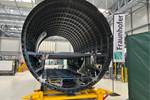Diehl Aviation sets up new aircraft interiors production in Mexico
The Querétaro site will start in mid-2025 with Airbus A220 overhead bins assembled in Québec, Canada and Alabama in the U.S.
Diehl Aviation (Überlingen, Germany) announces the establishment of Diehl Aviation de Mexico S. de R.L. de C.V. in an industrial park near Querétaro. The site will initially have 8,000 square meters of production/office space and employ around 30 people, growing to 500 staff in the medium term. Start of production, planned for the middle of 2025, will begin with particularly spacious overhead bins for the Airbus A220 assembled in Mirabel, Québec, Canada, and Mobile, Alabama.
Located roughly three hours northwest from Mexico City, the city of Querétaro has become a center of excellence for plastics, composites and aerospace manufacturing and maintenance, including:
- The third Albany Safran Composites facility making carbon fiber composite fan blades for the LEAP engine;
- TechOps MX, reported to be the largest aircraft maintenance, repair and overhaul (MRO) company in Mexico and second largest in Latin America, focusing on narrowbody and regional jet aircraft;
- The Aeronautical University in Querétaro (UNAQ), which provides customized training in composites and has spun off companies like RHEM Composites.
Diehl Aviation uses composites in several of its aircraft interiors products and features them in its Eco line of new developments. As explained in a 2023 article by Mary Kirby, the company is extending its supply of lightweight interiors for the large aircraft OEMs into development for electric vertical takeoff and landing (eVTOL) aircraft and advanced air mobility (AAM) companies.
Source | Diehl Aviation
For example, Diehl is supplying the cabin interior for the Lilium Jet, including sidewalls, ceiling panels, partitions, the luggage compartment and cabin floor. This interior also includes Diehl’s air conditioning ducts which use lightweight composites and materials such as foam granulates for air outlets.
“So, you even try to become lighter and lighter and lighter,” says Dr. Jörg Schuler, CEO of Diehl Aviation. This trajectory can be seen in the company’s Eco Efficiency products which include the 3D printed Eco Bracket made with 9T Labs’ composites technology, the thermoplastic composite Eco Bin and Eco Therompostic Ducting, as well as the Eco sidewall featuring basalt fiber and bio-based furane resin.
Diehl Aviation’s new location in Mexico is meant to further strengthen cooperation with important customers like Airbus, Boeing, Bombardier, Embraer and large local air carriers. The U.S. is an important growth market for Diehl. Being closer to its customers enables shorter travel and transport routes and more effective collaboration.
This increased responsiveness and local presence will improve Diehl Aviation’s competitiveness in the market. In addition to economic potential, the location in Mexico provides and enables more cost-efficient production, but also reduces product costs and creates a local supply chain. Moreover, Diehl gains access to more qualified employees.
Querétaro boasts a central location, excellent infrastructure, and proximity to Querétaro International Airport. Querétaro is also an important industrial location focusing on the aerospace industry and represents well-known companies such as Bombardier, Airbus, Safran and Delta Airlines.
Related Content
-
ASCEND program update: Designing next-gen, high-rate auto and aerospace composites
GKN Aerospace, McLaren Automotive and U.K.-based partners share goals and progress aiming at high-rate, Industry 4.0-enabled, sustainable materials and processes.
-
Infinite Composites: Type V tanks for space, hydrogen, automotive and more
After a decade of proving its linerless, weight-saving composite tanks with NASA and more than 30 aerospace companies, this CryoSphere pioneer is scaling for growth in commercial space and sustainable transportation on Earth.
-
Manufacturing the MFFD thermoplastic composite fuselage
Demonstrator’s upper, lower shells and assembly prove materials and new processes for lighter, cheaper and more sustainable high-rate future aircraft.


















